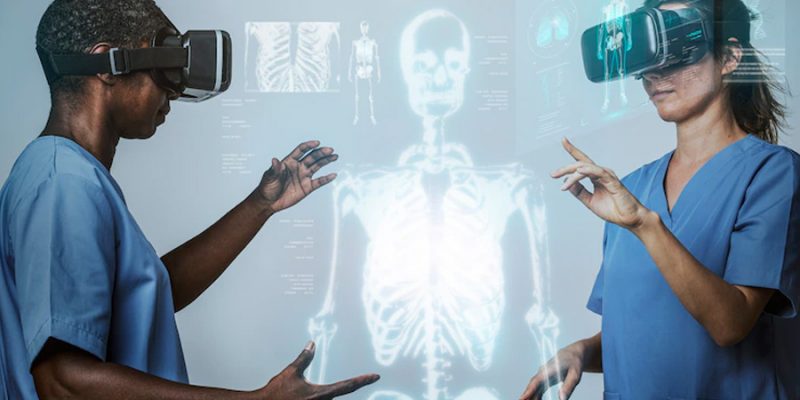
The Metaverse in Healthcare: augmented reality could be used to replace surgeons altogether
Metaverse in healthcare: the rise of augmented reality (AR) and virtual reality (VR) technology is transforming the healthcare industry in ways never before imagined. It is now possible to perform medical procedures without the need for a physical surgeon or hospital. This revolutionary technology is called the metaverse and it is set to revolutionize the healthcare industry. In this article, we’ll take a closer look at how AR could be used to replace surgeons altogether and how this could potentially improve the quality of healthcare worldwide.
What is the Metaverse?
The metaverse is an interconnected, virtual reality (VR) network of data, avatars, and objects that exist in a shared digital space. It’s a concept born from science fiction but has become more widely accepted as technology advances. This digital universe enables users to create, interact with, and explore 3D virtual worlds.
At its core, the metaverse is a digital representation of the physical world. It can be used for social interaction, entertainment, work, education, and many other activities. As a result, the metaverse is quickly becoming an important platform for companies to develop virtual experiences, products, and services.
The metaverse is already making its mark in the healthcare industry, with augmented reality (AR) technology playing a major role in its development. AR is being used to simulate real-world medical scenarios, making it easier for doctors and other healthcare professionals to practice their skills without any risk to patients. This technology also provides an opportunity to improve diagnosis accuracy, streamline patient data collection, and provide greater access to medical services.
What are the implications of the metaverse in healthcare?
The potential implications of the metaverse in healthcare are far-reaching. By leveraging virtual reality and augmented reality technology, healthcare providers could be enabled to provide more accurate diagnoses, treatments, and surgeries than ever before.
With the introduction of the metaverse, healthcare could become more efficient, personalized, and cost-effective. Virtual healthcare visits, remote surgery simulations, real-time patient monitoring, and remote robotic surgeries could all become possible. This could drastically reduce healthcare costs while simultaneously improving care quality.
The most obvious implication of the metaverse in healthcare is the possibility of remote surgeries, which could be conducted with a much higher degree of accuracy and precision than ever before. Augmented reality could be used to streamline and optimize surgical procedures while allowing surgeons to view 3D images of organs and tissues in real time. By creating a digital twin of the patient’s body, doctors would be able to get a detailed insight into the patient’s anatomy without having to open them up for surgery.
The potential implications of the metaverse in healthcare are virtually endless. With this technology, healthcare providers will be able to make more informed decisions, provide faster treatments and improve overall patient outcomes. It’s an exciting development that could revolutionize the way we approach healthcare.
How could augmented reality be used in surgeries?
Augmented reality (AR) has the potential to revolutionize healthcare, particularly when it comes to surgeries. By combining 3D visualization with haptics and robotics, surgeons can conduct procedures with more precision, accuracy, and control than ever before. With AR, surgeons are able to visualize every aspect of surgery, from the tissue being operated on to the placement of surgical instruments. This allows for greater safety, accuracy, and efficiency.
In addition, AR can be used in remote surgeries. Surgeons are able to view an operation in real-time, with all the data they need to be projected onto their headset or device. They are able to view patient information, such as vital signs and imaging scans, in order to make better-informed decisions. This eliminates the need for an assistant in the operating room, which can be a costly overhead.
Furthermore, AR allows for a new level of training and education for medical professionals. Surgeons are able to use virtual models and simulations to practice their skills before performing actual surgeries. This can reduce the risk of complications during actual operations, as well as improve their surgical skills.
Finally, AR can be used to customize patient treatments. By using 3D visualizations, surgeons are able to tailor treatments to each individual patient, ensuring that the best possible outcomes are achieved.
Overall, augmented reality has the potential to revolutionize the way surgeries are performed. By using 3D visualizations, haptics and robotics, surgeons can conduct more accurate and efficient operations with greater safety and precision than ever before. In addition, AR can be used to provide virtual training and simulations for medical professionals, as well as enable remote surgeries. Finally, AR can be used to tailor treatments to individual patients. With these benefits in mind, it’s clear that AR could soon become an integral part of the healthcare industry.
What are the benefits of using AR in surgeries?
Augmented reality (AR) has the potential to revolutionize the way healthcare is delivered, and the application of AR in surgeries could bring about numerous benefits. AR can be used to visualize information and data that may not be visible in real time, which can provide surgeons with better insight and accuracy during operations. Additionally, it can help to reduce patients’ risk of post-operative complications by giving surgeons a much more detailed view of the body’s interior.
AR can also be used to reduce the amount of time spent in surgery, as well as improve recovery times. By utilizing AR technology, surgeons can be guided through complex surgeries with greater precision and accuracy, which can reduce the time it takes to perform the procedure. This can also benefit patients, who can expect shorter hospital stays and faster recovery periods.
Another benefit of using AR in surgeries is that it can reduce the need for general anesthesia, as well as potentially reduce the risk of infection. By using augmented reality, surgeons can get a more precise view of the body without having to open up large areas of skin, meaning that only minimal anesthesia is required. This helps reduce the risk of complications due to excess anesthesia, as well as reducing the chances of surgical site infections.
In conclusion, there are numerous benefits to using augmented reality in surgeries. From improved accuracy and precision to faster recovery times and reduced risk of complications, this technology could truly revolutionize the way healthcare is delivered in the future.



















